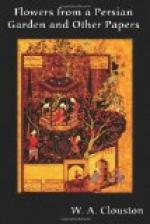Of this last class is the popular Persian work, Tuti Nama, (Tales of a Parrot, or Parrot-Book), of which I purpose furnishing some account, as it has not yet been completely translated into English. This work was composed, according to Pertsch, in A.D. 1329, by a Persian named Nakhshabi, after an older Persian version, now lost, which was made from a Sanskrit work, also no longer extant, but of which the modern representative is the Suka Saptati, or Seventy Tales of a Parrot.[41] The frame, or leading story, of the Persian Parrot-Book is to the following effect:
[41] Ziyau-’d-Din Nakhshabi,
so called from Nakhshab, or
Nasaf,
the modern Kashi, a town situated between
Samarkand
and the Oxus, led a secluded life in Bada’um,
and
died, as stated by ’Abdal-Hakk, A.H. 751 (A.D.
1350-1).—Dr.
Rieu’s Catalogue of Persian MSS. in the
British
Museum.—In 1792 the Rev. B. Gerrans
published
an
English translation of twelve of the fifty-two tales
comprised
in the Tuti Nama, but the work is now best
known
in Persia and India from an abridgment made by
Kadiri
in the last century, which was printed, with a
translation,
at London in 1801.
A merchant who had a very beautiful wife informs her one day that he has resolved to travel into foreign countries in order to increase his wealth by trade. His wife endeavours to persuade him to remain at home in peace and security instead of imperiling his life among strangers. But he expatiates on the evils of poverty and the advantages of wealth: “A man without riches is fatherless, and a home without money is deserted. He that is in want of cash is a nonentity, and wanders in the land unknown. It is, therefore, everybody’s duty to procure as much money as possible; for gold is the delight of our lives—it is the bright live-coal of our hearts—the yellow links which fasten the coat of mail—the gentle stimulative of the world—the complete coining die of the globe—the traveller who speaks all languages, and is welcome in every city—the splendid bride unveiled—the defender, register, and mirror of jehandars. The man who has dirhams [Scottice,




